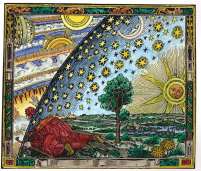The
practice of Kabbalah has been going through something of a renaissance in recent years, and with celebrities such as Madonna
talking publicly about its benefits many people have become interested in the subject. At the same time as gaining in popularity
modern Kabbalah has also evolved and morphed from its ancient origins so that what I call 'modern Kabbalah' is something quite
different from the traditional subject. In this article I will try to give a general outline of, and introduction to, the
study and practice of modern Kabbalah.
The
origins of Kabbalah lie in early Jewish mysticism, but from those beginnings the study of Kabbalah has grown and branched
out, first into a Christian and Islamic Kabbalah, and then further, so that today many people who study and practice Kabbalah
do so outside of any particular religious affiliations, treating it as an independent spiritual system in itself. Within Jewish
legend there are two distinct stories of the origins of Kabbalah; the first states that it was received by Moses on mount
Sinai, but whereas the commandments were for everybody the esoteric teachings of the Kabbalah were passed on to a select few
as a secret inner teaching. The second states that these teachings have always been with man, having been given to Adam by
an Archangel at the time of his expulsion from the Garden of Eden, out of pity for his plight and a desire to help.
Within
Judaism the Torah and other 'exoteric' teachings were often considered to be the body of Jewish teaching, and the Kabbalah,
at the height of its practice, was considered to be the soul. In many ways Kabbalistic teachings can be thought of as the
distilled essence of spiritual teachings, without the cultural baggage and rigid dogmas that go along with religious teachings.
It is because of this that the Kabbalah has been so successful at moving out of the confines of the Jewish faith to provide
inspiration, guidance and empowerment to people of all different backgrounds and beliefs. The modern study of Kabbalah has
become intimately entwined with the concept of the 'Perennial Philosophy'; the idea that there is a unifying thread of truth
behind all of the world’s main religious and spiritual teachings. Kabbalistic principles and teats can be used to understand
and draw upon the teachings of a wide range of very different spiritual traditions by stripping away everything but the perfect
'essence' or soul of the teaching.
The
esoteric nature of Kabbalah means that rather than being composed of a set of rules, rituals and dogmas, and being essentially
social and collective in nature, like exoteric religions, it guides its practitioners on a very personal journey and is composed
in a large part of techniques; the path of Kabbalah is that of mysticism and magick, an of philosophy rather than dogma.

